On Friday, Oct. 2, the Army National Guard removed a deadly pileup of logs from the Esopus Creek where 14-year-old Jordyn Engler drowned last month.
A warning sign has also been installed, apparently in the last 24 hours, by the New York Department of Environmental Conservation (DEC) at the entrance to the fishing access point at the Shandaken cemetery where Jordyn Engler died on Sept. 5.
Soldiers operating an excavator and a bulldozer worked for hours Friday morning to remove the logs and debris, known as a strainer, that trapped Engler while she was on a tubing excursion with her father on Labor Day weekend.
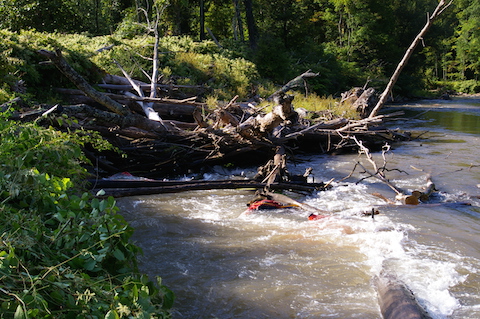
Above: The strainer where Jordyn Engler drowned, photographed on Sept. 6, 2015.
The strainer was a well-known hazard that had first formed in 2005. It has choked that portion of the Esopus Creek for a decade. By noon on Friday, it was gone.
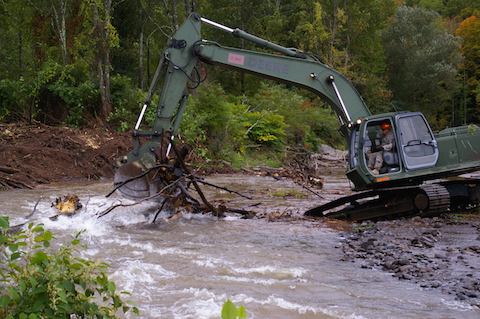
Above: An excavator operated by the New York Army National Guard clears the deadly strainer from the Esopus on Oct. 1.
Removing debris from streams in the Catskills is normally a difficult process that requires permits and carries a large risk of liability.
It appears that local and state officials took advantage of an emergency declaration authorizing stream debris removal in advance of Hurricane Joaquin to remove the strainer in the Esopus.
On Thursday, Oct. 1, Gov. Andrew Cuomo made an emergency declaration deploying the National Guard to “critical debris removal sites around the state.”
“DEC is working with local officials to identify potential problem areas where debris removal could help prevent flooding in the event Joaquin hits New York,” the statement read.
When Cuomo made the declaration, Hurricane Joaquin was expected to bring rain to the East Coast of the United States this weekend. The latest forecasts now say it will veer out to sea.
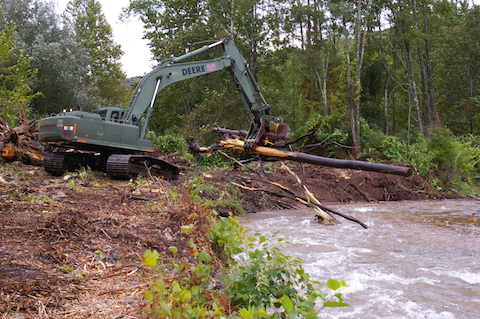
Above: An excavator removes the vestiges of the strainer from the Esopus Creek on Oct. 2, 2015.
The Esopus strainer was one of four sites across the state that was prioritized by the DEC for emergency cleanup today by the 204th Engineer Battalion of the New York Army National Guard, according to Major Chad Clark, who was on the scene at the Esopus today.
The other three sites earmarked for cleanup are not in the Catskills, Clark said.
The DEC did not respond to a request for comment.
Above: An excavator crosses the Esopus Creek while removing debris from a strainer.
Calls for more signage, education
Officials from the DEC joined other river stewards and concerned citizens at a meeting of the Ashokan Watershed Stream Management Program’s Stream Access and Recreation Committee on Wednesday, Sept. 30 to discuss safety at the strainer site, according to Marc Hollander, the co-chair of the committee.
After Engler’s drowning, Hollander spearheaded a campaign calling for an amendment to the New York Constitution to make it easier to clear debris from streams in the Catskills.
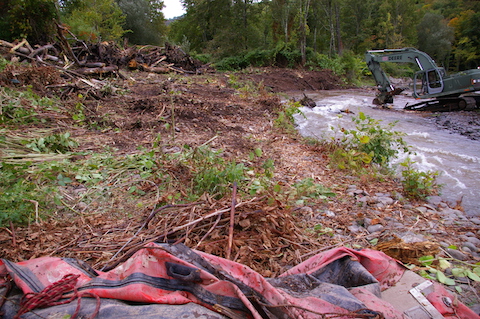
Above: In just a few hours on Oct. 1, the New York Army National Guard removed a huge amount of debris--and two ruined swiftwater rescue boats--from a pile of logs and branches where 14-year-old Jordyn Engler died last month. The soldiers plan to move the debris as far away from the river as possible so that it will not be swept downstream to create new hazards.
Now, in the wake of the meeting, Hollander is not sure that a constitutional amendment is necessary.
The entities that own the land near the strainer might be able to allow debris clearing without an amendment, he said.
“Anything within 500 feet of a road that’s potentially high access could be cleared,” he said.
So now, Hollander’s focus is “the protocol for identifying these strainers, real hazards, in the river,” he said.
Although the strainer that killed Jordyn Engler is gone, it may return, Hollander said, because debris will almost certainly pile up at the site again.
“That’s a natural kink in the river,” he said.
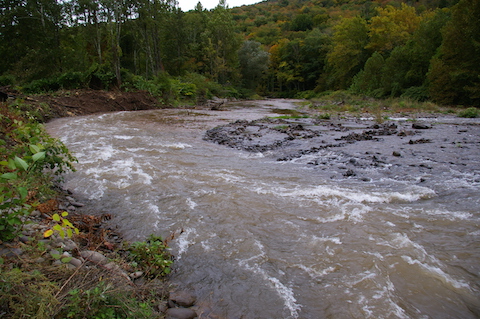
Above: The former site of the strainer was clear by noon on Friday, Oct. 1.
The Stream Access and Recreation Committee is focusing on two strategies: better signage and more education and instruction, Hollander said. He is hoping to involve local scouting troops in making kiosks and signs along the Esopus.
Earlier this week, Hollander himself personally installed homemade warning signs at the Shandaken cemetery site.
“I just went to FedEx office and laminated two eight-and-a-half-by-eleven pieces of paper,” he said.
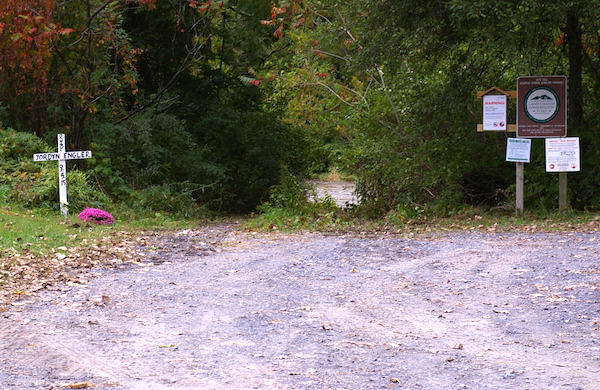
Above: A new warning sign, right, has been installed at the Shandaken cemetery fishing access point. On the left is a cross remembering Jordyn Engler, who drowned at the site.
Those homemade signs have now been replaced with an official DEC sign that appears to have been installed within the last 24 hours.
The new sign reads:
WARNING! SWIFT WATER, STRONG CURRENTS, DOWNED TREES. THIS IS A FISHING ACCESS SITE. It is not safe to go tubing, canoeing or kayaking at this location. Please consider boating or tubing well downstream of this access point.
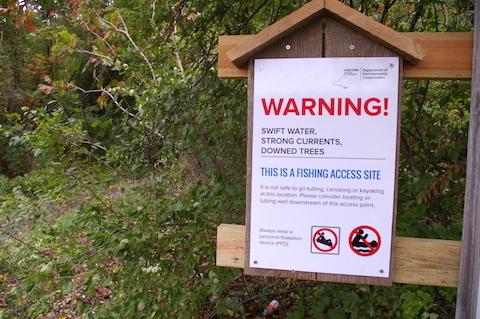
Above: A warning sign has been installed at the Shandaken cemetery fishing access point on the Esopus Creek warning tubers and boaters to avoid the area.
Recreational release, canoe race cancelled
Jordyn Engler died during “Shandaken Whitewater Weekend,” when the New York City Department of Environmental Protection raised the level of the Esopus Creek by opening the gates of the Shandaken portal to allow extra water to flow into the Esopus from the Schoharie Reservoir.
Another recreational release had been requested for this weekend, Oct. 3 and 4, by the American Canoe Association, which needed the extra water for its long-running Esopus Slalom race.
That release request has been denied by the DEC, according to the DEC’s website, and the race has been cancelled.
Adam Bosch, a spokesman for the NYC DEP, said that the DEC denied the release request for this weekend because of recent heavy rains that have filled the river and the surrounding reservoirs, causing uncertainty about how much more flow the Esopus can handle.
“Because of all the uncertainty, the request was not met,” Bosch said.
Bosch said that there are no more release requests pending at this time. Usually, recreational groups and town officials request releases four times a year: in June, July, September and October.
Previous coverage:
Father of girl who drowned in Esopus Creek speaks out, Oct. 1, 2015
Teen drowned while tubing after bus dropped her near notorious hazard, Sept. 9, 2015
14-year-old drowns in Esopus Creek, police say, Sept. 5, 2015















